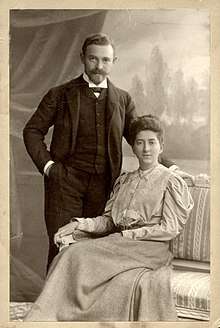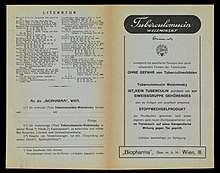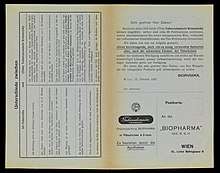Friedrich Weleminsky
| Friedrich Weleminsky | |
|---|---|
 Portrait picture of Friedrich & Jenny Weleminsky c. 1905–1910 | |
| Born |
1868 Golčův Jeníkov, Austrian Empire (now Czech Republic) |
| Died |
1945 London, England |
| Residence | Prague, Czechoslovakia; Thalheim, Lower Austria; and London, England |
| Nationality | Austrian (from birth); British (from 1940s) |
| Spouse(s) | Jenny Weleminsky |
| Children | Three daughters and one son: Marianne; Anton; Elisabeth (Jardenah); Dora (Leah) |


Friedrich ("Fritz") Weleminsky (1868, Golčův Jeníkov – 1945, London), was a physician and a lecturer in Hygiene (now called Microbiology) at the German University, Prague who, before the Second World War, created an alternative treatment for tuberculosis.[1]
He was born into a Jewish family in 1868 at Golčův Jeníkov in Bohemia, which was then part of the Austrian Empire and is now in the Czech Republic. On 4 December 1905 he married Jenny Elbogen at her parents' country home, Schloss Thalheim, Lower Austria.[note 1] The married couple lived in Prague and at Schloss Thalheim,[1] which Jenny had inherited from her father and which they ran as a model dairy farm.
Facing Nazi persecution for being Jewish, Friederich and Jenny Weleminsky found sanctuary in 1939 in Britain.[1][2] They had four children together; two emigrated to Mandatory Palestine in the 1930s and two came to Britain. Their grandchildren and great-grandchildren now live in Britain, Israel, Australia, Sweden and Germany.
Tuberculomucin Weleminsky
In 1912 Weleminsky, who was then second assistant to the head of the Institute for Hygiene at the German University of Prague, published his discovery of a new treatment for tuberculosis, which he named tuberculomucin (Tbm).[3] It was tested on guinea pigs,[4] with number 1769 being the first to survive due to the treatment in 1909.[5] He also used tuberculomucin Weleminsky[6] to treat cattle which he kept at Schloss Thalheim.
More than 60 papers were published in German describing tuberculomucin's use in humans, but very few of them were read by an English-speaking audience. By the mid-1920s it was known as tuberculomucin Weleminsky and at least two companies were involved in producing and marketing the treatment.[note 2] In 1938, Sanders, a Belgian pharmaceutical company, planned to manufacture Tbm and to make it available in Western Europe and other parts of the developed world. However, Weleminsky fled Prague in 1938 a couple of weeks before the Nazi invasion of Czechoslovakia and these plans and further development of the treatment ceased.[7]
In 2011, following an approach by Weleminsky’s granddaughter, Dr Charlotte Jones, a retired general practitioner, a team at the University College London's Department of Science and Technology Studies resumed research on tuberculomucin Weleminsky.[8]
Publications
- Weleminsky, Friedrich (1899). Über Sporenbildung bei Dematium pululans de Bary, 7pp.
- Weleminsky, Friedrich (1899). Ueber Akklimitisation in Grossstädten (On acclimisation in large cities), Oldenbourg: Munich. Off-print from Archiv für Hygiene, 26: 2
- Jadassohn, J; Pick, Walther; Weleminsky, Friedrich (1903). "Buchanzeigen und Besprechungen". Archiv für Dermatologie und Syphilis, 64(1): 149–160
- Weleminsky, Friedrich (1914). "Tierversuche mit Tuberculomucin". Berliner klinische Wochenschr. 18: 1–10
- Weleminsky, Friedrich (1928). "Filtrable form of tubercle bacilli". Zentralbl Ges Tuberk Forsch. 28(5/6): 305–310
- Weleminsky, Friedrich (1930). "Die Immunisierung gegen Tuberkulose mit Calmette's BCG" Klin Wschr. II:1317–1320
- Weleminsky, Friedrich (1932). "Die neuere B.C.G.-Literatur in französischer Sprache". 36: 7–8
Note
- ↑ Schloss Thalheim is in the village of Thalheim (Kapelln), today a part of Kapelln, Sankt Pölten-Land District; See de:Liste der denkmalgeschützten Objekte in Kapelln#Denkmäler, Jakob Prandtauer. The property was damaged during the Second World War. After restoration it reopened in 2016 as a luxury hotel.
- ↑ The 1927 advertisement, pictured here, was issued by the Biopharma pharmaceutical company in Vienna. It listed the distinctions between tuberculin and tuberculomucin Weleminsky and invited general practitioners and clinical physicians to seek a brochure about TbM, or trial samples for clinical testing, by completing and returning a postcard in which they were also asked to say if they were already using Tbm and what success they had experienced in using it.
References
- 1 2 3 Reeves, Carole (4 April 2012). "Tuberculomucin – a forgotten treatment for tuberculosis". Carole Reeves. Retrieved 3 April 2013.
- ↑ Jones, Charlotte (July 2011). "My grandfather: A kind and modest man" (PDF). AJR Journal. Association of Jewish Refugees. 11 (7): 5.
- ↑ Ebringer, Libor (April 1993). "Czechoslovakia, Czechoslovak Society for Microbiology and the world (Plenary lecture at the 19th Congress of Czechoslovak Society for Microbiology, Košice, 19 September 1992)". Folia Microbiologica. Springer Netherlands. 38 (2): 83-96. ISSN 1874-9356. Retrieved 4 August 2017.
- ↑ Von Ruck, Karl; Von Ruck, Sylvio (1916). Studies in Immunization Against Tuberculosis. New York: Paul B Hoeber. p. 120.
- ↑ Weleminsky, Friedrich (1914). "Tierversuche mit Tuberculomucin". Berliner klinische Wochenschr. 18: 1–10.
- ↑ Zemmin, H; Wille, K (October 1926). "Beitrag zur Tuberkulosetherapie mit Tuberculomucin". Beiträge zur Klinik der Tuberkulose und spezifischen Tuberkulose-Forschung (Contributions to clinical tuberculosis and tuberculosis – specific research). 64 (5–6): 679 – 682. ISSN 0341-2040. doi:10.1007/BF02093958.
- ↑ "Spotlight on Carole Reeves". University College London. 5 March 2014. Retrieved 4 August 2017.
- ↑ "UCL Donors help fund a forgotten treatment for TB". University College London Department of Science and Technology Studies. 13 February 2014. Retrieved 31 July 2017.